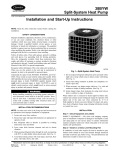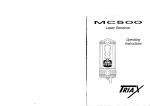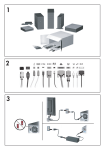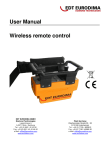Download HP RP2 Getting Started Guide
Transcript
Getting Started HP Retail Systems © Copyright 2012, 2013 Hewlett-Packard Development Company, L.P. The information contained herein is subject to change without notice. Microsoft and Windows are U.S. registered trademarks of the Microsoft group of companies. The information contained herein is subject to change without notice. The only warranties for HP products and services are set forth in the express warranty statements accompanying such products and services. Nothing herein should be construed as constituting an additional warranty. HP shall not be liable for technical or editorial errors or omissions contained herein. Getting Started HP Retail Systems First Edition: May 2012 Second Edition: December 2013 Document Part Number: 697963-002 Product Notice Software terms This guide describes features that are common to most models. Some features may not be available on your computer. By installing, copying, downloading, or otherwise using any software product preinstalled on this computer, you agree to be bound by the terms of the HP End User License Agreement (EULA). If you do not accept these license terms, your sole remedy is to return the entire unused product (hardware and software) within 14 days for a refund subject to the refund policy of your place of purchase. Not all features are available in all editions of Windows 8. This computer may require upgraded and/or separately purchased hardware, drivers and/or software to take full advantage of Windows 8 functionality. See http://www.microsoft.com for details. This computer may require upgraded and/ or separately purchased hardware and/or a DVD drive to install the Windows 7 software and take full advantage of Windows 7 functionality. See http://windows.microsoft.com/en-us/ windows7/get-know-windows-7 for details. For any further information or to request a full refund of the computer, please contact your local point of sale (the seller). About This Book WARNING! Text set off in this manner indicates that failure to follow directions could result in bodily harm or loss of life. CAUTION: Text set off in this manner indicates that failure to follow directions could result in damage to equipment or loss of information. NOTE: Text set off in this manner provides important supplemental information. Accessing User Guides and HP Diagnostics (Windows systems) The menu and books are displayed in the language chosen during initial system setup or as specified later in the Windows Regional Settings. If the Regional Settings do not match one of the supported languages, the menu and books are displayed in English. To access HP user guides: ▲ Select Start > All Programs > HP Help and Support > HP User Manuals. To access Vision Diagnostics: ▲ Refer to Accessing Vision Diagnostics in this guide. To access the Safety and Comfort Guide: ▲ Select Start > All Programs > HP Help and Support > HP User Manuals > Safety and Comfort Guide. How to Check Warranty and Support Entitlement Your warranty is available on the hard drive (some models). To access your warranty: ▲ Select Start > All Programs > HP Help and Support > Warranty You may check your warranty entitlement by entering your product model number and serial number at: http://www.hp.com/support/warranty-lookuptool HP Care Pack Services registration can be checked at: http://www.hp.com/go/lookuptool/ iii iv About This Book Table of contents Getting Started .................................................................................................................................................... 1 Installing and customizing the software ................................................................................................ 1 Installing the Windows Operating system ............................................................................ 1 Downloading Microsoft Windows updates ........................................................................... 2 Installing or upgrading device drivers (Windows systems) .................................................. 2 Customizing the monitor display (Windows systems) .......................................................... 2 Accessing disk image (ISO) files ......................................................................................... 3 Protecting the software ......................................................................................................................... 3 Using HP Diagnostic Solutions ............................................................................................................. 3 Vision Diagnostics (select models only) .............................................................................. 3 Accessing Vision Diagnostics (select models only) ............................................ 4 HP PC Hardware Diagnostics (select models only) ............................................................. 4 Why run HP PC Hardware Diagnostics ............................................................... 4 How to access and run HP PC Hardware Diagnostics ....................................... 5 Downloading HP PC Hardware Diagnostics to a USB device ............................ 5 Turning off the computer ...................................................................................................................... 5 Finding more information ...................................................................................................................... 6 Before you call for technical support .................................................................................................... 6 Helpful hints .......................................................................................................................................... 7 Basic troubleshooting ........................................................................................................................... 8 Interpreting POST diagnostic front panel LEDs and audible codes ..................................... 8 Backing up, restoring, and recovering in Windows 7 and POSReady 7 .............................................. 8 Creating recovery media ...................................................................................................... 9 Creating recovery media using HP Recovery Manager (select models only) ..... 9 Creating recovery discs with HP Recovery Disc Creator (select models only) . 10 Creating recovery discs .................................................................... 11 Backing up your information .............................................................................. 11 System Restore ................................................................................................................. 12 System Recovery ............................................................................................................... 12 System Recovery when Windows is responding .............................................. 13 System Recovery when Windows is not responding ........................................ 13 System Recovery using recovery media (select models only) .......................... 14 v Using HP Recovery Disc operating system discs (select models only) ............ 15 Backing up, restoring, and recovering in Windows 8.1, Windows 8, or Industry 8.1 .......................... 16 Creating recovery media and backups .............................................................................. 16 Restoring and recovering using Windows tools ................................................................. 16 Using Reset when the system is not responding .............................................. 17 Recovery using the Windows recovery USB flash drive ................................... 17 Recovery using Windows operating system media (purchased separately) ..... 18 Using, updating, and maintaining your PC (Windows 7, POSReady 7, Windows 8.x, and Industry 8.1 systems) ......................................................................................................................... 18 vi Getting Started Installing and customizing the software If your computer was not shipped with a Microsoft operating system, some portions of this documentation do not apply. Additional information is available in online help after you install the operating system. CAUTION: Do not add optional hardware or third-party devices to the computer until the operating system is successfully installed. Doing so may cause errors and prevent the operating system from installing properly. Installing the Windows Operating system The first time you turn on the computer, the operating system is installed automatically. This process takes about 5 to 10 minutes, depending on which operating system is being installed. Carefully read and follow the instructions on the screen to complete the installation. CAUTION: Once the automatic installation has begun, DO NOT TURN OFF THE COMPUTER UNTIL THE PROCESS IS COMPLETE. Turning off the computer during the installation process may damage the software that runs the computer or prevent its proper installation. NOTE: If the computer shipped with more than one operating system language on the hard drive, the installation process could take up to 60 minutes. Installing and customizing the software 1 Downloading Microsoft Windows updates 1. To set up your Internet connection, click Start > Internet Explorer and follow the instructions on the screen. 2. In Windows 7, POSReady 7, Windows XP, and POSReady 9, click Start > All Programs > Windows Update. In Windows 7 and POSReady 7, the Windows Update screen appears. Click view available updates and make sure all critical updates are selected. Click the Install button and follow the instructions on the screen. In Windows XP and POSReady 2009, you will be directed to the Microsoft Windows Update Web site. If you see one or more pop-up windows that ask you to install a program from http://www.microsoft.com, click Yes to install the program. Follow the instructions on the Microsoft Web site to scan for updates and install critical updates and service packs. In Windows 8.x and Industry 8.1, point to the upper-right or lower-right corner of the Start screen to display the charms. Select Settings > Change PC Settings > Windows Update and follow the instructions on the screen. It is recommended that you install all of the critical updates and service packs. 3. After the updates have been installed, Windows will prompt you to reboot the machine. Be sure to save any files or documents that you may have open before rebooting. Then select Yes to reboot the machine. 4. Run Windows Update monthly thereafter. Installing or upgrading device drivers (Windows systems) When installing optional hardware devices after the operating system installation is complete, you must also install the drivers for each of the devices. If prompted for the i386 directory, replace the path specification with C:\i386, or use the Browse button in the dialog box to locate the i386 folder. This action points the operating system to the appropriate drivers. Obtain the latest support software, including support software for the operating system from http://www.hp.com/support. Select your country and language, select Drivers & Downloads, enter the model number of the computer, and click the Go button. Customizing the monitor display (Windows systems) If you wish, you can select or change the monitor model, refresh rates, screen resolution, color settings, font sizes, and power management settings. To change display settings in Windows XP, right-click on the Windows Desktop and select Properties. To change display settings in Windows 7 and POSReady 7, right-click on the Windows Desktop and select Personalize. In Windows 8.x and Industry 8.1, you can customize display settings for the Start screen and Desktop. To customize the Start screen, point to the upper-right or lower-right corner of the Start screen to display the charms. Select Settings > Change PC Settings > Personalize and change the 2 Getting Started display settings. To customize the Desktop, right-click on the Desktop, and then select Personalize to change the display settings. For more information, refer to the online documentation provided with the graphics controller utility or the documentation that came with your monitor. Accessing disk image (ISO) files There may be disk image files (ISO files) included on your PC that contain the installation software for additional software. These CD image files are located in the folder C:\SWSetup\ISOs. Each .iso file can be burned to CD media to create an installation CD. It is recommended that these disks be created and the software installed in order to get the most from your PC. If present, the software and image file names are: ● Vision Diagnostics – software to perform diagnostic activities on your PC Protecting the software To protect the software from loss or damage, keep a backup copy of all system software, applications, and related files stored on the hard drive. Refer to the operating system or backup utility documentation for instructions on making backup copies of your data files. If you cannot create system recovery CDs or DVDs, you can order a recovery USB flash drive from the HP support center. To obtain the support center telephone number for your region see http://www.hp.com/support/contactHP. Using HP Diagnostic Solutions The HP diagnostic strategy has changed over time. Vision Diagnostics was used on Retail units in a Windows environment until October of 2012. Since November 2012, HP is utilizing HP PC Hardware Diagnostics, which are diagnostics used outside the Windows environment. Vision Diagnostics (select models only) NOTE: Vision Diagnostics is included on CD with some computer models only. The Vision Diagnostics utility allows you to view information about the hardware configuration of the computer and perform hardware diagnostic tests on the subsystems of the computer. The utility simplifies the process of effectively identifying, diagnosing, and isolating hardware issues. The Survey tab is displayed when you invoke Vision Diagnostics. This tab shows the current configuration of the computer. From the Survey tab, there is access to several categories of information about the computer. Other tabs provide additional information, including diagnostic test options and test results. The information in each screen of the utility can be saved as an html file and stored on a diskette or USB flash drive. Use Vision Diagnostics to determine if all the devices installed on the computer are recognized by the system and functioning properly. Running tests is optional but recommended after installing or connecting a new device. You should run tests, save the test results, and print them so that you have printed reports available before placing a call to the Customer Support Center. NOTE: Third party devices may not be detected by Vision Diagnostics. Protecting the software 3 Accessing Vision Diagnostics (select models only) To access Vision Diagnostics, you must copy the utility onto a USB flash drive then boot to the USB flash drive. NOTE: Vision Diagnostics is included with some computer models only. If you have already downloaded Vision Diagnostics to a USB flash drive, then begin the following procedure at step 2. 1. Select Start > All Programs > HP Help and Support > HP Vision Diagnostics USB Creation and follow the wizard prompts to install Vision Diagnostics on the USB flash drive. 2. While the computer is on, insert the USB flash drive into the a USB port on the computer. 3. Shut down the operating system and turn off the computer. 4. Turn on the computer. The system will boot into Vision Diagnostics. NOTE: If the system does not boot to the USB flash drive, you may need to change the boot order in the Computer Setup utility. Refer to the Maintenance and Service Guide (English only) for more information. 5. At the boot menu, select either the Vision Diagnostics utility to test the various hardware components in the computer or the HP Memory Test utility to test memory only. NOTE: The HP Memory Test is a comprehensive memory diagnostic utility that is run as a stand-alone application, outside of Vision Diagnostics. 6. If running Vision Diagnostics, select the appropriate language and click Continue. 7. In the End User License Agreement page, select Agree if you agree with the terms. The Vision Diagnostics utility launches with the Survey tab displayed. HP PC Hardware Diagnostics (select models only) The UEFI-based hardware diagnostic solution is included with some HP products. You can use this tool even if the computer will not boot to the operating system. Why run HP PC Hardware Diagnostics The HP PC Hardware Diagnostic tools simplify the process of diagnosing hardware issues and expedite the support process when issues are found. The tools save time by pinpointing the component that needs to be replaced. 4 ● Isolate true hardware failures: The diagnostics run outside of the operating system so they effectively isolate hardware failures from issues that may be caused by the operating system or other software components. ● Failure ID: When a failure is detected that requires hardware replacement, a 24-digit Failure ID is generated. This ID can then be provided to the call agent, who will either schedule support or provide replacement parts. Getting Started How to access and run HP PC Hardware Diagnostics You can run the diagnostics from one of three places, depending on your preference and the health of the computer. 1. Turn on the computer and press Esc repeatedly until the BIOS Boot Menu appears. 2. Press F2 or select Diagnostics (F2). Pressing F2 signals the system to search for the diagnostics in the following locations: a. A connected USB drive (to download the diagnostics tools to a USB drive, see the instructions in Downloading HP PC Hardware Diagnostics to a USB device on page 5) b. The hard disk drive c. A core set of diagnostics in the BIOS (for memory and hard disk drive) that are accessible only if the USB or hard disk drive versions are not detected Downloading HP PC Hardware Diagnostics to a USB device 1. Go to http://www.hp.com. 2. Click the Drivers & Downloads link. 3. Enter the product name in the text box and click the Go button. 4. Select your specific computer model. 5. Select your operating system. 6. In the Diagnostic section, click the HP UEFI Support Environment link. This link provides additional information. - or Click the Download button and select Run. The download includes instructions (in English) on how to install the tools on the USB device. NOTE: HP diagnostic solutions are developed to test components typically included on HP products. They may not diagnose all third-party accessories that can be added to the system. Turning off the computer To properly turn off the computer, first shut down the operating system software. In Windows 7, POSReady 7, and Windows XP Professional, click Start > Shut Down. In Windows 8.x and Industry 8.1, point to the upper-right or lower-right corner of the Start screen to display the charms, and then select Settings > Power icon > Shut down. Depending on the operating system, pressing the power button may cause the computer to enter a low-power or “standby” state instead of automatically turning the power off. This allows you to conserve energy without closing software applications; later, you can start using the computer immediately without having to restart the operating system and without losing any data. CAUTION: Manually forcing the computer off will cause the loss of any unsaved data. To force the computer off manually and bypass the “standby state,” press and hold the power button for four seconds. Turning off the computer 5 On some models, you can reconfigure the power button to work in On/Off mode by running Computer Setup. Refer to the Maintenance and Service Guide (English only) for more information about using the Computer Setup utility. Finding more information The following publications are available on the computer hard drive. To access the publications, select Start > All Programs > HP User Manuals. NOTE: Not all of the publications listed are included on all models. ● Getting Started—Helps you connect the computer and peripheral devices and set up factoryprovided software; also includes basic troubleshooting information should you encounter any problems during initial startup. ● Hardware Reference Guide—Provides an overview of the product hardware, as well as instructions for upgrading this series of computers; includes information on RTC batteries, memory, and power supply. ● Maintenance and Service Guide (English only)—Provides information on parts removal and replacement, troubleshooting, Desktop Management, setup utilities, safety, routine care, connector pin assignments, POST error messages, diagnostic indicator lights and error codes. ● Safety & Regulatory Information Guide—Provides safety and regulatory information that ensures compliance with U.S., Canadian, and various international regulations. Before you call for technical support WARNING! When the computer is plugged into an AC power source, voltage is always applied to the system board. To reduce the risk of personal injury from electrical shock and/or hot surfaces, be sure to disconnect the power cord from the wall outlet and allow the internal system components to cool before touching. If you are having problems with the computer, try the appropriate solutions below to try to isolate the exact problem before calling for technical support. ● Run the HP Diagnostic Solution ● Run the Drive Protection System (DPS) Self-Test in Computer Setup. Refer to the Maintenance and Service Guide (English only) for more information. NOTE: The Drive Protection System (DPS) Self-Test software is available on some models only. 6 ● Check the power LED on the front of the computer to see if it is flashing or listen for a series of beeps emanating from the computer. The flashing lights and/or beeps are error codes that will help you diagnose the problem. Refer to the Maintenance and Service Guide (English only) for details. ● If the screen is blank, plug the monitor into a different video port on the computer if one is available. Or, change out the monitor with a monitor that you know is functioning properly. ● If you are working on a network, plug another computer with a different cable into the network connection. There may be a problem with the network plug or cable. Getting Started ● If you recently added new hardware, remove the hardware and see if the computer functions properly. ● If you recently installed new software, uninstall the software and see if the computer functions properly. ● Boot the computer to the Safe Mode to see if it will boot without all of the drivers loaded. When booting the operating system, use “Last Known Configuration.” ● Refer to the comprehensive online technical support at http://www.hp.com/support. ● Refer to Helpful hints on page 7 in this guide for more general suggestions. ● Refer to the comprehensive Maintenance and Service Guide (English only) for more detailed information. To assist you in resolving problems online, HP Support Wizard provides you with self-solve diagnostics. If you need to contact HP support, use HP Support Wizard's online chat feature. Access HP Support Wizard at: http://www.hp.com/go/ispe. Access the HP Support Center at http://www.hp.com/go/bizsupport for the latest online support information, software and drivers, proactive notification, and worldwide community of peers and HP experts. If it becomes necessary to call for technical assistance, be prepared to do the following to ensure that your service call is handled properly: ● Be in front of your computer when you call. ● Write down the computer serial number and product ID number, and the monitor serial number before calling. ● Spend time troubleshooting the problem with the service technician. ● Remove any hardware that was recently added to your system. ● Remove any software that was recently installed. NOTE: For sales information and warranty upgrades (HP Care Pack), call your local authorized service provider or dealer. Helpful hints If you encounter problems with the computer, monitor, or software, see the following list of general suggestions before taking further action: ● Check that the computer and monitor are plugged into a working electrical outlet. ● Check to see that the computer is turned on and the power light is on. ● Check to see that the monitor is turned on and the monitor light is on. ● Turn up the brightness and contrast controls of the monitor if the monitor is dim. ● Press and hold any key. If the system beeps, then the keyboard should be operating correctly. ● Check all cable connections for loose connections or incorrect connections. Helpful hints 7 ● Wake the computer by pressing any key on the keyboard or pressing the power button. If the system remains in suspend mode, shut down the computer by pressing and holding the power button for at least four seconds. Then press the power button again to restart the computer. If the system will not shut down, unplug the power cord, wait a few seconds, then plug it in again. The computer will restart if automatic start on power loss is set in Computer Setup. If it does not restart, press the power button to start the computer. ● Reconfigure your computer after installing a non–plug and play expansion board or other option. ● Be sure that all the needed device drivers have been installed. For example, if you are using a printer, you need a driver for that model printer. ● Remove all bootable media (CD, DVD, or USB device) from the system before turning it on. ● If you have installed an operating system other than the factory-installed operating system, check to be sure that it is supported on the system. ● If the system has multiple video sources (embedded, PCI, or PCI-Express adapters) installed (embedded video on some models only) and a single monitor, the monitor must be plugged into the monitor connector on the source selected as the primary input source. During boot, the other monitor connectors are disabled and if the monitor is connected into these ports, the monitor will not function. You can select which source will be the default input source in Computer Setup. CAUTION: When the computer is plugged into an AC power source, there is always voltage applied to the system board. You must disconnect the power cord from the power source before opening the computer to prevent system board or component damage. Basic troubleshooting You can find troubleshooting information in the comprehensive Maintenance and Service Guide (English only) available under the reference library at http://www.hp.com/support. Select your country and language, select Troubleshooting, enter the model number of the computer, and press the Go button. Interpreting POST diagnostic front panel LEDs and audible codes If you see flashing LEDs on the front of the computer or if you hear beeps, see the Maintenance and Service Guide (English only) for interpretation and recommended action. Backing up, restoring, and recovering in Windows 7 and POSReady 7 Your computer includes tools provided by HP and Windows to help you safeguard your information and retrieve it if you ever need to. These tools will help you return your computer to a proper working state or even back to the original factory state, all with simple steps. This section provides information about the following processes: ● Creating recovery media and backups ● Restoring and recovering your system NOTE: This section describes an overview of backing up, restoring, and recovering options. For more details about the Windows Backup and Restore tools provided, see Help and Support. To access Help and Support, select Start > Help and Support. 8 Getting Started Recovery after a system failure is only as good as your most recent backup. 1. After you successfully set up the computer, create recovery media. This media can be used to reinstall the original operating system in cases where the hard drive is corrupted or has been replaced. See Creating recovery media on page 9. 2. As you add hardware and software programs, create system restore points. A system restore point is a snapshot of certain hard drive contents saved by Windows System Restore at a specific time. A system restore point contains information that Windows uses, such as registry settings. Windows creates a system restore point for you automatically during a Windows update and during other system maintenance (such as a software update, security scanning, or system diagnostics). You can also manually create a system restore point at any time. For more information and steps for creating specific system restore points, see Help and Support. To access Help and Support, select Start > Help and Support. 3. As you add photos, video, music, and other personal files, create a backup of your personal information. If files are accidentally deleted from the hard drive and they can no longer be restored from the Recycle Bin, or if files become corrupted, you can restore the files that you backed up. In case of system failure, you can use the backup files to restore the contents of your computer. See Backing up your information on page 11. NOTE: HP recommends that you print the recovery procedures and save them for later use, in case of system instability. Creating recovery media After you successfully set up the computer, create recovery media. The media can be used to reinstall the original operating system in cases where the hard drive is corrupted or has been replaced. There are two types of recovery media. To determine which steps to follow for your computer: 1. Click the Start button. 2. Click All Programs. ● If Security and Protection is listed, continue with the steps in Creating recovery media using HP Recovery Manager (select models only) on page 9. ● If Productivity and Tools is listed, continue with the steps in Creating recovery discs with HP Recovery Disc Creator (select models only) on page 10. Creating recovery media using HP Recovery Manager (select models only) ● To create recovery discs, your computer must have a DVD writer. Use DVD+R or DVD-R discs (purchased separately). The discs you use will depend on the type of optical drive you are using. NOTE: DVD+R DL, DVD-R DL, or DVD±RW disc are not supported. ● You have the option of creating a recovery USB flash drive instead, using a high-quality USB drive. Backing up, restoring, and recovering in Windows 7 and POSReady 7 9 ● If you are creating recovery discs, be sure to use high-quality discs. It is normal for the system to reject defective discs. You will be prompted to insert a new blank disc to try again. ● The number of discs in the recovery-disc set depends on your computer model (typically 3 to 6 DVDs). The Recovery Media Creation program tells you the specific number of blank discs needed to make the set. If you are using a USB flash drive, the program will tell you the size of the drive required to store all the data (minimum of 8 GB). NOTE: The process of creating recovery media is lengthy. You can quit the process at any time. The next time you initiate the process, it resumes where it left off. NOTE: Do not use media cards for creating recovery media. The system may not be able to boot up from a media card and you may not be able to run system recovery. To create recovery discs: 1. Close all open programs. 2. Click the Start button, click All Programs, click Security and Protection, click Recovery Manager, and then click HP Recovery Media Creation. If prompted, click Yes to allow the program to continue. 3. Click Create recovery media using blank DVD(s), and then click Next. 4. Follow the on-screen instructions. Label each disc after you make it (for example, Recovery 1, Recovery 2), and then store the discs in a secure place. To create a recovery USB flash drive: NOTE: You must use a USB flash drive with a capacity of at least 8 GB. NOTE: Recovery Media Creation formats the USB flash drive, deleting any files on it. 1. Close all open programs. 2. Insert the USB flash drive into a USB port on the computer. 3. Click the Start button, click All Programs, click Security and Protection, click Recovery Manager, and then click Recovery Media Creation. 4. Click Create recovery media with a USB flash drive, and then click Next. 5. Select the USB flash drive from the list of media. The program will let you know how much storage is required to create the recovery drive. If the USB flash drive does not have enough storage capacity, it will appear grayed out, and you must replace it with a larger USB flash drive. Click Next. 6. Follow the on-screen instructions. When the process is complete, label the USB flash drive and store it in a secure place. Creating recovery discs with HP Recovery Disc Creator (select models only) HP Recovery Disc Creator is a software program that offers an alternative way to create recovery discs on select models. After you successfully set up the computer, you can create recovery discs using HP Recovery Disc Creator. The recovery discs allow you to reinstall your original operating 10 Getting Started system as well as select drivers and applications if the hard drive becomes corrupted. HP Recovery Disc Creator creates two kinds of recovery discs: ● Operating system DVD—Installs the operating system without additional drivers or applications. ● Driver Recovery DVD—Installs specific drivers and applications only, in the same way that the HP Software Setup utility installs drivers and applications. To create recovery discs, your computer must have a DVD writer. Use any of the following types of discs (purchased separately): DVD+R, DVD+R DL, DVD-R, DVD-R DL, or DVD±RW. The discs you use will depend on the type of optical drive you are using. Creating recovery discs NOTE: The operating system DVD can be created only once. The option to create that media will not be available after you create a Windows DVD. To create the Windows DVD: 1. Select Start > All Programs > Productivity and Tools > HP Recovery Disc Creator. 2. Select Windows disk. 3. From the drop-down menu, select the drive for burning the recovery media. 4. Click the Create button to start the burning process. Label the disc after you create it, and store it in a secure place. After the operating system DVD has been created, create the Driver Recovery DVD: 1. Select Start > All Programs > Productivity and Tools > HP Recovery Disc Creator. 2. Select Driver disk. 3. From the drop-down menu, select the drive for burning the recovery media. 4. Click the Create button to start the burning process. Label the disc after you create it, and store it in a secure place. Backing up your information You should create your initial backup immediately after initial system setup. As you add new software and data files, you should continue to back up your system on a regular basis to maintain a reasonably current backup. Your initial and subsequent backups allow you to restore your data and settings if a failure occurs. You can back up your information to an optional external hard drive, a network drive, or discs. Note the following when backing up: ● Store personal files in the Documents library, and back it up regularly. ● Back up templates that are stored in their associated directories. ● Save customized settings that appear in a window, toolbar, or menu bar by taking a screen shot of your settings. The screen shot can be a time-saver if you have to reset your preferences. ● When backing up to discs, number each disc after removing it from the drive. Backing up, restoring, and recovering in Windows 7 and POSReady 7 11 NOTE: For detailed instructions on various backup and restore options, perform a search for these topics in Help and Support. To access Help and Support, select Start > Help and Support. NOTE: You may be prompted by User Account Control for your permission or password when you perform certain tasks. To continue a task, select the appropriate option. For information about User Account Control, see Help and Support: Select Start > Help and Support. To create a backup using Windows Backup and Restore: NOTE: The backup process may take over an hour, depending on file size and the speed of the computer. 1. Select Start > All Programs > Maintenance > Backup and Restore. 2. Follow the on-screen instructions to set up your backup. System Restore If you have a problem that might be due to software that you installed on your computer, or if you want to restore the system to a previous state without losing any personal information, use System Restore to return the computer to a previous restore point. NOTE: Always use this System Restore procedure before you use the System Recovery feature. To start System Restore: 1. Close all open programs. 2. Click the Start button, right-click Computer, and then click Properties. 3. Click System protection, System Restore, click Next, and then follow the on-screen instructions. System Recovery WARNING! This procedure will delete all user information. To prevent loss of information, be sure to back up all user information so you can restore it after recovery. System Recovery completely erases and reformats the hard disk drive, deleting all data files that you have created, and then reinstalls the operating system, programs, and drivers. However, you must reinstall any software that was not installed on the computer at the factory. This includes software that came on media included in the computer accessory box, and any software programs you installed after purchase. Any personal files must be restored from backups you made. If you were not able to create system recovery DVDs or USB flash drive, you can order a recovery disc set from support. Go to http://www.hp.com/support, select your country or region, and follow the on-screen instructions. NOTE: Always use the System Restore procedure before you use the System Recovery program. See System Restore on page 12. 12 Getting Started You must choose one of the following methods to perform a System Recovery: ● Recovery image — Run System Recovery from a recovery image stored on your hard disk drive. The recovery image is a file that contains a copy of the original factory-shipped software. To perform a System Recovery from a recovery image, see System Recovery when Windows is responding on page 13 or System Recovery when Windows is not responding on page 13. ● Recovery media — Run System Recovery from recovery media that you have created from files stored on your hard disk drive or purchased separately. See System Recovery using recovery media (select models only) on page 14. System Recovery when Windows is responding CAUTION: System Recovery deletes all data and programs you created or installed. Before you begin, back up any important data to a CD or DVD or to a USB flash drive. NOTE: In some cases, you must use recovery media for this procedure. If you have not already created this media, follow the instructions in Creating recovery media on page 9. If the computer is working and the operating system is responding, use these steps to perform a System Recovery: 1. Turn off the computer. 2. Disconnect all peripheral devices from the computer except the monitor, keyboard, and mouse. 3. Turn on the computer. 4. When Windows has loaded, click the Start button, and then click All Programs. ● If Security and Protection is listed, continue with step 5. ● If Productivity and Tools is listed, follow the steps in System Recovery when Windows is not responding on page 13. 5. Click Security and Protection, click Recovery Manager, and then click Recovery Manager. If prompted, click Yes to allow the program to continue. 6. Under I need help immediately, click System Recovery. 7. Select Yes, and then click Next. Your computer restarts. 8. When the computer restarts, you will see the Recovery Manager welcome screen again. Under I need help immediately, click System Recovery. If you are prompted to back up your files, and you have not done so, select Back up your files first (recommended), and then click Next. Otherwise, select Recover without backing up your files, and then click Next. 9. System Recovery begins. After System Recovery is complete, click Finish to restart the computer. 10. When Windows has loaded, shut down the computer, reconnect all peripheral devices, and then turn the computer back on. System Recovery when Windows is not responding CAUTION: System Recovery deletes all data and programs you created or installed. Backing up, restoring, and recovering in Windows 7 and POSReady 7 13 If Windows is not responding, but the computer is working, follow these steps to perform a System Recovery. 1. Turn off the computer. If necessary, press and hold the power button until the computer turns off. 2. Disconnect all peripheral devices from the computer, except the monitor, keyboard, and mouse. 3. Press the power button to turn on the computer. 4. As soon as you see the HP logo screen, repeatedly press the F11 key on your keyboard until the Windows is Loading Files… message appears on the screen. 5. At the HP Recovery Manager screen, follow the on-screen instructions to continue. 6. When Windows has loaded, shut down the computer, reconnect all peripheral devices, and then turn the computer back on. System Recovery using recovery media (select models only) Use the steps provided in this section if you created recovery media using Creating recovery media using HP Recovery Manager (select models only) on page 9. If you used HP Recovery Disc Creator to create an operating system DVD and a Driver Recovery DVD, use the steps in Using HP Recovery Disc operating system discs (select models only) on page 15. CAUTION: System Recovery deletes all data and programs you have created or installed. Back up any important data to a CD or DVD or to a USB flash drive. To perform a System Recovery using recovery media: 1. If you are using a set of DVDs, insert the first recovery disc into the DVD drive tray, and close the tray. If you are using a recovery USB flash drive, insert it into a USB port. 2. Click the Start button, and then click Shut Down. or If the computer is not responding, press and hold the power button for approximately 5 seconds or until the computer turns off. 14 3. Disconnect all peripheral devices from the computer except the monitor, keyboard, and mouse. 4. Press the power button to turn on the computer, and press Esc as the computer is powering on to display the startup menu. 5. Use the arrow keys to select the boot menu, and press Enter. Use the arrow keys to select the location where the recovery media is inserted (USB or DVD). Press Enter to boot from that device. 6. If Recovery Manager asks if you want to run System Recovery from Media or Hard Drive, select Media. On the Welcome screen, under I need help immediately, click Factory Reset. 7. If you are prompted to back up your files, and you have not done so, select Back up your files first (recommended), and then click Next. Otherwise, select Recover without backing up your files, and then click Next. 8. If you are prompted to insert the next recovery disc, do so. Getting Started 9. When Recovery Manager is finished, remove the recovery disc or the recovery USB flash drive from the system. 10. Click Finish to restart the computer. Using HP Recovery Disc operating system discs (select models only) Use the steps provided in this section if you used HP Recovery Disc Creator to create an operating system DVD and a Driver Recovery DVD. If you created recovery media using Creating recovery media using HP Recovery Manager (select models only) on page 9. use the steps in System Recovery using recovery media (select models only) on page 14. If you cannot use the recovery discs you previously created using the HP Recovery Disc Creator (select models only), you must purchase an operating system DVD to reboot the computer and repair the operating system. To order an operating system DVD, contact support. Go to http://www.hp.com/support, select your country or region, and follow the on-screen instructions. CAUTION: Using a Windows 7 or POSReady operating system DVD completely erases the hard drive contents and reformats the hard drive. All files that you have created and any software that you have installed on the computer are permanently removed. When reformatting is complete, the recovery process helps you restore the operating system, as well as drivers, software, and utilities. To initiate recovery using a Windows 7 or POSReady operating system DVD: NOTE: This process takes several minutes. 1. If possible, back up all personal files. 2. Restart the computer, and then insert the operating system DVD into the optical drive before the Windows operating system loads. NOTE: If the computer does not boot to the DVD, restart the computer and press Esc as the computer is powering on to see the startup menu. Use the arrow keys to select the boot menu and press Enter. Use the arrow keys to select the location where the recovery DVD is inserted. Press Enter to boot from that device. 3. When prompted, press any keyboard key. 4. Follow the on-screen instructions. 5. Click Next. 6. Select Install now. 7. Follow the on-screen instructions. After the repair is completed: 1. Eject the operating system DVD and then insert the Driver Recovery DVD. 2. Follow the on-screen instructions to install the Hardware Enabling Drivers first, and then install Recommended Applications. Backing up, restoring, and recovering in Windows 7 and POSReady 7 15 Backing up, restoring, and recovering in Windows 8.1, Windows 8, or Industry 8.1 Your computer includes tools provided by HP and Windows to help you safeguard your information and retrieve it if you ever need to. These tools will help you return your computer to a proper working state or even back to the original factory state, all with simple steps. This section provides information about the following processes: ● Creating recovery media and backups ● Restoring and recovering your system NOTE: This section describes an overview of backing up, restoring, and recovering options. For more details about the tools provided, see Help and Support. From the Start screen, type help, and then select Help and Support. Creating recovery media and backups Recovery after a system failure is only as good as your most recent backup. 1. After you successfully set up the computer, create recovery media. This step creates a backup of the recovery partition on the computer. The backup can be used to reinstall the original operating system in cases where the hard drive is corrupted or has been replaced. NOTE: There is no recovery partition on systems with a 32GB SSD. For those systems, you must use the recovery media in the box or that can be obtained from HP Services. You will use a USB flash drive to create a bootable recovery drive that can be used to troubleshoot a computer that is unable to start. The USB flash drive can be used to reinstall the original operating system and the programs that were installed at the factory. NOTE: Any information on the USB flash drive will be erased before the recovery media is created. 2. ● To create the Windows 8.1 or Industry 8.1 recovery media, from the Start screen, type recovery drive, then click on Create a recovery drive. Follow the on-screen instructions to continue. ● To create the Windows 8 recovery media, from the Start screen, type recovery drive, and then click on Settings, then click on Create a recovery drive. Follow the on-screen instructions to continue. Use the Windows tools to create system restore points and create backups of personal information. For more information and steps, see Help and Support. From the Start screen, type help, and then select Help and Support. Restoring and recovering using Windows tools Windows offers several options for restoring from backup, refreshing the computer, and resetting the computer to its original state. For more information and steps, see Help and Support. From the Start screen, type help, and then select Help and Support. 16 Getting Started Using Reset when the system is not responding NOTE: You may be prompted by User Account Control for your permission or password when you perform certain tasks. To continue a task, select the appropriate option. For information about User Account Control, see Help and Support. From the Start screen, type help, and then select Help and Support. IMPORTANT: Reset does not provide backups of your information. Before using Reset, back up any personal information you wish to retain. If Windows recovery steps are not working and the system is not responding, use these steps to start Reset: 1. If possible, back up all personal files. 2. If possible, check for the presence of the HP Recovery partition: ● For Windows 8.1 or Industry 8.1, from the Start screen, type pc, and then select This PC. ● For Windows 8, from the Start screen, type c, and then select Computer. NOTE: If the HP Recovery partition is not listed, or you cannot check for its presence, you must recover using the recovery media you created; see Recovery using the Windows recovery USB flash drive on page 17. Or you must use the Windows operating system media and the Driver Recovery media (purchased separately); see Recovery using Windows operating system media (purchased separately) on page 18. 3. If the HP Recovery partition is listed, restart the computer, and then press esc while the HP logo is displayed. The computer Startup Menu displays. 4. Press f11 to select the System Recovery option. 5. Choose your keyboard layout. 6. Select Troubleshoot. 7. Select Reset. 8. Follow the on-screen instructions to continue. Recovery using the Windows recovery USB flash drive To recover your system using the recovery USB flash drive you previously created: NOTE: If you did not create a recovery USB flash drive or the one you created does not work, see Recovery using Windows operating system media (purchased separately) on page 18. 1. If possible, back up all personal files. 2. Insert the recovery USB flash drive you created into a USB port on your computer. 3. Restart the computer and as soon as you see the HP logo screen, press f9 to display a list of boot devices. Use the arrow keys to select your USB flash drive from the UEFI Boot Sources list. Press Enter to boot from that device. 4. Choose your keyboard layout. 5. Select Troubleshoot. Backing up, restoring, and recovering in Windows 8.1, Windows 8, or Industry 8.1 17 6. Select Refresh your PC. 7. Follow the on-screen instructions. Recovery using Windows operating system media (purchased separately) To order a Windows operating system DVD, contact support. Go to http://www.hp.com/support, select your country or region, and follow the on-screen instructions. CAUTION: Using Windows operating system media completely erases the hard drive contents and reformats the hard drive. All files that you have created and any software that you have installed on the computer are permanently removed. When reformatting is complete, the recovery process helps you restore the operating system, as well as drivers, software, and utilities. To initiate recovery using Windows operating system media: NOTE: This process takes several minutes. 1. If possible, back up all personal files. 2. Restart the computer, and then follow the instructions provided with the Windows operating system media to install the operating system. 3. When prompted, press any keyboard key. 4. Follow the on-screen instructions. After the repair is completed and the Windows desktop appears: 1. Remove the Windows operating system media, and then insert the Driver Recovery media. 2. Install the Hardware Enabling Drivers first, and then install Recommended Applications. Using, updating, and maintaining your PC (Windows 7, POSReady 7, Windows 8.x, and Industry 8.1 systems) Systems with Windows 7 or POSReady 7 provide a centralized location to easily manage your PC, including the following: ● View or change your computer name and other system settings ● Add a device or printer and change other system settings ● Get help and support for your specific model ● Install HP support software for your computer ● Purchase supplies and accessories for your computer To access the centralized PC management location in Windows 7 and POSReady 7, click Start > Devices and Printers then double-click on the picture of your PC. To access the centralized PC management location in Windows 8.x and Industry 8.1, point to the upper-right or lower-right corner of the Start screen to display the charms, and then select Settings > Change PC Settings. 18 Getting Started

































